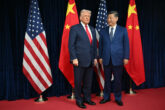September 11, 2016
Preventing Nuclear War with North Korea
Few anticipated that 2016 would see such unprecedented missile and nuclear testing in North Korea, most recently its fifth and largest ever test, reportedly coming in at 10 kilotons. But none of this should have come as a surprise. Under Kim Jong Un, North Korea’s approach to developing its strategic forces is markedly different—more aggressive—than it was under his father or grandfather. The striking change puts the Korean Peninsula on a path to nuclear war unless the U.S.-South Korean alliance can adapt to the constraints of deterrence and defense against a second-tier nuclear-armed adversary.
To read the full article, visit the Foreign Affairs website.
More from CNAS
-
North Korea Reveals Troop Dispatch to Russia amid U.S.-South Korea Policy Talks
North Korea has confirmed for the first time that its troops are operating in Russia, and it is preparing to rewrite its party charter with the possibility of officially namin...
By Dr. Go Myong-Hyun
-
Chinese Maker of Bitcoin-Mining Machines Is a Security Threat, Says Expert
Bloomberg News reports that a Chinese manufacturer, Bitmain Technologies Ltd, that sells most of the world’s Bitcoin-mining machines — including 16,000 of them to a venture ba...
By David Feith
-
Indo-Pacific Security / Energy, Economics & Security
North Korea’s Provocations, Power Plays, and Shifting AlliancesTensions on the Korean Peninsula have reached a new and dangerous threshold. President Lee Jae Myung is warning of a real risk of accidental military clashes, as the situation...
By Dr. Go Myong-Hyun
-
Indo-Pacific Security / Energy, Economics & Security
How to Win the Economic War with ChinaTrump's approach to China has run aground, giving Beijing unprecedented advantage in the economic conflict....
By Edward Fishman & Julian Gewirtz



